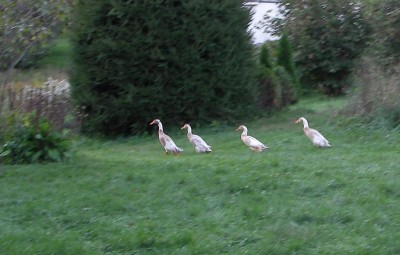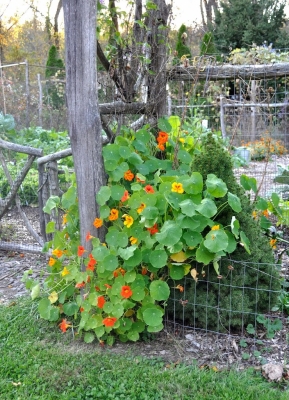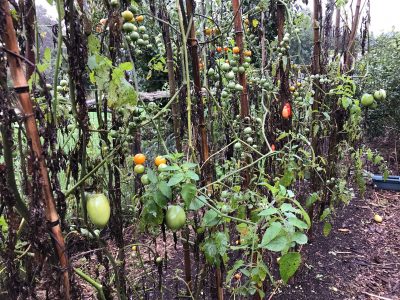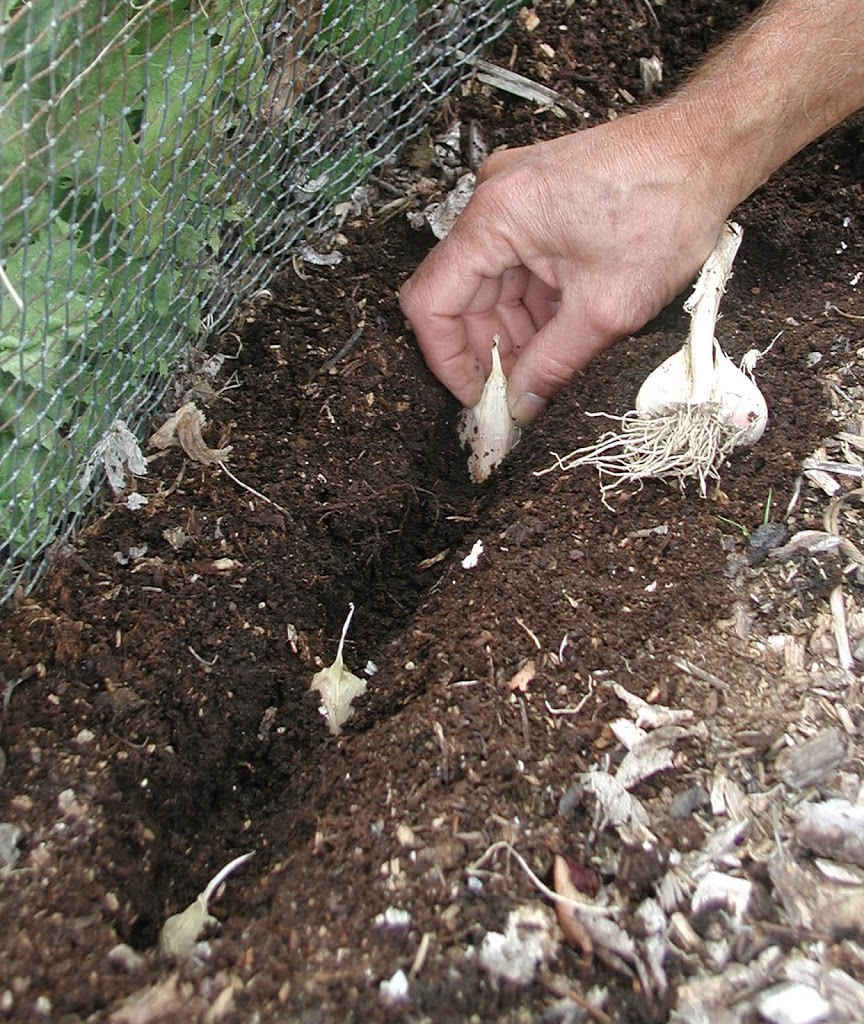Happy “Nose Twist,” Sad Tomatoes
Nasturtium In Its Element
It’s nice to see that at least someone or thing enjoys the current cool, wet weather. My eight ducks, for instance. As I open the door to “duckingham palace,” each duck pads out onto the slurpy ground as happy as a lark (a lark on a sunny day, I assume).  Also enjoying this awful weather are the oat cover crops that I’ve sown in some of my vegetable beds. The oats are especially lush and green, as is your and my lawn grass. The same goes for beds I recently planted with lettuce, radishes, arugula, turnips and other cool weather vegetables.
Also enjoying this awful weather are the oat cover crops that I’ve sown in some of my vegetable beds. The oats are especially lush and green, as is your and my lawn grass. The same goes for beds I recently planted with lettuce, radishes, arugula, turnips and other cool weather vegetables.
Nasturtium flowers, which I planted back in May, went hardly noticed all season long. But now they are lush, their red flowers boldly staring out against the background of their round disks of bluish green leaves.
The plants’ present prominence comes, first, from the weather. Native from the cool highlands of Mexico down into Chile and Argentina, the plants feel right at home, and show it with their luxuriant growth, when I’m beginning to feel chilly. They also have come into prominence because some of their neighboring plants — marigolds, cucumbers, and tomatoes, for example — are waning.
Nasturtium offers a lot of bang for the buck, so for many years, each May, I’ve dropped the seeds into holes I poke into the ground. Mostly I plant them near my garden gates but also, some years, along the wide, main path at the head of each of the vegetable beds. The latter planting was an emulation of painter Claude Monet’s well-known nasturtium plantings that softened the wide path beneath his long arbor. The plant isn’t really a climber, but may be called a clamberer; that’s how it makes its way partway up nearby gates and wire fences.
Nasturtium seeds germinate readily once the soil warms sufficiently and then are care-free all summer long. The large size of the seeds and their quick germination make them fun for children to plant and watch.
Sometimes the plants are so care-free as to need some discipline. The ones I planted along my path required pruning to keep them from meeting in the middle and obliterating the path.
Nasturtium offers more than just beauty. All parts of the plant are edible. The leaves add a pungent pizazz to a sandwich, the flowers add pizazz and eye appeal to a salad. The immature seeds can be pickled as stand-ins for capers. One nasturtium species, called mashua in some parts of the world, is a perennial producing edible tubers. This one is an actual climber rather than a clamberer.
And Now, for Nose Twist
Nasturtium got its common name because of its similarity in taste to watercress, which is botanically Nasturtium officiale. The word “nasturtium” comes from the Latin words nasus, meaning “nose,” and torqueum, meaning “twist,” which is what the peppery flavor of watercress or nasturtium does.
Despite one plant sharing its common name with the botanical name of the other, nasturtium and watercress are not in the same family. They do, however, share certain flavor profiles (which is why both are nose twisters). So much so that the cabbage white butterfly will feed on nasturtium as well as its namesake, cabbage. But not with great enthusiasm. The caterpillar phase of the cabbage white butterfly will only feed on nasturtium if it did so from birth; try feeding it to the second or third instar of this insect, and it would rather starve, literally!
The genus for nasturtium is Tropaeolum, the “trop” part related to the word “trophy.” Founder of plant taxonomy, Carl von Linnaeus, assigned this name because the clambering flowers and leaves reminded him of the helmets and shields of the vanquished which were draped on tree branches following battles in his day.
Tomatoes Exit
In contrast to the nasturtiums, my tomato plants are not at all happy with the weather now — or for much of this summer. Humid conditions have fostered diseases, the usual leaf spotting diseases (early blight, late blight, and septoria leaf spot) as well as anthracnose.
Anthracnose is particularly vexing because apparently sound tomatoes develop the sunken, rotting lesions from this disease after only a day or so on the kitchen counter.
A thorough cleanup of all tomato leaves, stems, and fruits, covering the ground with compost, and moving tomato plantings to new locations should help limit disease next year. Also, wearing red shoes and clicking my heals together three times before planting might help.
The passing of tomatoes isn’t all that bad because they don’t taste that good in this weather. And we do have a reasonable amount broadcasting their richness through the sparkling clear glass of canning jars.



Hi Lee,
You’re a gardener for all seasons. Thanks for the enlightening comments on nasturtiums. Plants were made to be beautiful as well as edible.
Cheers,
Jerry
Nice that you mentioned nasturtiums: I love them, and particularly Out of Africa with its variegated foliage. They are sprawling everywhere! I would attach a pix if I could. Also doing well right now are my Asian greens and Kale.
Richmond Green Apple cucmber doesn’t mind this weather either: where most of the other cukes are yellowed and ugly, these are till putting out great little orbs just an6 hour or so north of you!
Quick question: Are nasturiums deer-resistant? I do not fence parts of my garden, so if they can fend off the deer, nasturtiums would be a beautiful addition.
I found that my tomatoes weren’t happy this year, too, and put it down to the wet weather.
Nasturtiums might be deer resistant, or not, but even if they are deer resistant does not make them deer repellent.
I’m excited to see you have ducks! I just got back inside from “walking” with my ducks in the pouring rain this morning. We have too many predators in northern Vermont to let them free range, but mine go out twice a day to forage and swim when possible.
I’m curious about why you keep ducks. Would you like to write about it?
I keep ducks for insect control, for eggs, for decoration, and for entertainment (they’re funny to watch). Other than that, and providing them shelter, closed in at night, water, and occasional food (they are very free range), I know very little about ducks.
Dr. ReichThis year my three pear trees did not flower nor they produce any fruit at all!!! Last year each one gave me about 50 to 60 pears-very tasty as well. The last two years I”ve had no wasps or bees around the house or yard. Could this have been the reason? Actually I do not recall any white flower buddings in the spring.
What action should be on my list for this coming year?
I did not do a good job of cutting off of the so-called water spouts.
Your thoughts, please!
Tony Ferreira
Your trees might have gotten into an alternate bearing habit, in which case they could potentially bear heavily next year. Even out their annual production by, next year, thinning fruits so that none are closer than about a foot apart.
A question about the american persimmon
First off, i have your small
Fruits book, have been up to your farmette to take class and have heard u lecture at NOFA a bunch over the years. Thanks for all your good work and it’s dissemination.
I have a jack rick in the ground which has yet to flower. I have room for another fruit tree or another american persimmon. I have access to a straight american persimmon species, or the following cultivations: yates, miller and
Szuki.
Im curious if the above trees will enhance fruit set/production on the john rick. And
Would the john rick influence better fruit set on the species or cultivars i noted?
Or should i just choose another fruit tree?
Thanks for your time and happy growing andrea jacobson, great barrington, Ma
Neither John Rick and Szukis need cross-pollination so neither is necessary to get more fruit from the other. You wrote that the John Rick has yet to flower. Don’t plant a seedling: You won’t know it’s sex, the fruit might not ripen this far north, and if it does it might not taste good.
Do you eat nasturtium or pickle the seeds?
Love your site
I just add the flowers to salads. Don’t want my nose to get too twisted. 🙂
Thank you for all the great gardening advice! My favorite nasturtium is Alaska,I love the marbled leaves, and the seed pack says it helps keep rabbits away. I have a question about rotating crops, I was thinking about switching the garden spots of tomatoes and cucumbers. Would this be beneficial? Thanks, Ellen
Yes, switch the cukes and tomatoes. It’s always good to move plants to a new location.